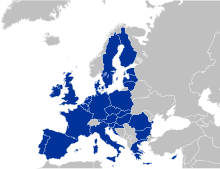External border of the European Union
Appearance

The border of the European Union consists of the borders with the countries which are not members of the European Union.
List of bilateral borders
- Albania–Greece border
- Andorra-France border
- Andorra-Spain border
- Austria–Liechtenstein border
- Austria–Switzerland border
- Belarus-Latvia border
- Belarus-Lithuania border
- Belarus–Poland border
- Bosnia and Herzegovina–Croatia border
- Brazil-France border
- Bulgaria–Republic of Macedonia border
- Bulgaria–Serbia border
- Bulgaria–Turkey border
- Croatia–Montenegro border
- Croatia–Serbia border
- Estonia–Russia border
- Finland–Norway border
- Finland–Russia border
- France-Sint Maarten border
- France–Switzerland border
- Germany–Switzerland border
- Greece–Republic of Macedonia border
- Greece–Turkey border
- Hungary–Serbia border
- Hungary–Ukraine border
- Italy–San Marino border
- Italy–Switzerland border
- Italy-Vatican City border
- Latvia–Russia border
- Lithuania–Russia border
- Moldova–Romania border
- Norway–Sweden border
- Poland–Russia border
- Poland–Ukraine border
- Romania–Serbia border
- Romania–Ukraine border
- Slovakia–Ukraine border
Border status and cooperation
In 2004 the European Union developed the European Neighbourhood Policy (ENP) for the promotion of cooperation between the EU and its neighbors to the East and South of the European territory of the EU (i.e., excluding its outermost regions),[1] which, in part, includes the Cross-Border Cooperation programme aimes at the promotion of economic development in border areas and ensure border security.[2]
References
External links
- Grigore Silaşi, Ovidiu Laurian Simina (eds.), Migration, Mobility and Human Rights at the Eastern Border of the European Union: Space of Freedom and Security, 2008, Editura Universităţii de Vest, ISBN 978-973-125-160-8
